flat tire PONTIAC GRAND-PRIX 1993 Owners Manual
[x] Cancel search | Manufacturer: PONTIAC, Model Year: 1993, Model line: GRAND-PRIX, Model: PONTIAC GRAND-PRIX 1993Pages: 338, PDF Size: 17.3 MB
Page 4 of 338
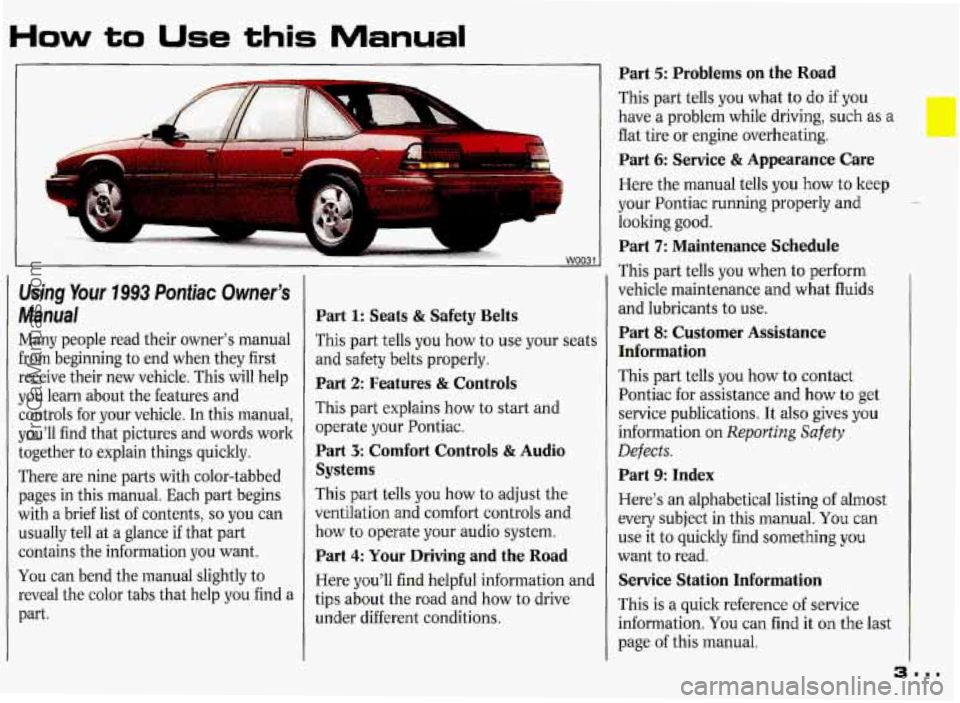
How to Use this Manual
b
Using Your 1993 Pontiac Owner’s
Manual
Many people read their owner’s manual
from beginning to end when they first
receive their new vehicle. This will help
you learn about the features and
controls for your vehicle. In this manual,
you’ll find that pictures and words work
together to explain things quicltly.
There are nine parts with color-tabbed pages in this manual. Each part begins
with a brief list of contents,
so you can
usually tell at a glance if that part
contains the information you want.
You can bend the manual slightly to
reveal the color tabs that help you find a
part.
Part 1: Seats & Safety Belts
This part tells you how to use your seat:
and safety belts properly.
Part 2: Features 8z Controls
This part explains how to start and
operate your Pontiac.
Part 3: Comfort Controls & Audio
Systems
This part tells you how to adjust the
ventilation
and comfort controls and
how to operate your audio system.
Part 4: Your Driving and the Road
Here you’ll find helpful information anc
tips about the road and how to drive
under different conditions.
Part 5: Problems on the Road
This part tells you what to do if you
have a problem while driving, such as a
flat tire or engine overheating.
Part 6: Service & Appearance Care
Here the manual tells you how to keep
your Pontiac running properly and
looking good.
Part 7: Maintenance Schedule
This part tells you when to perform
vehicle maintenance and what fluids
and lubricants to use.
Part 8: Customer Assistance
Information
This part tells you how to contact
Pontiac for assistance and how
to get
service publications. It also gives you
information on
Reporting Safety
Defects.
Part 9: Index
Here’s an alphabetical listing of almost
every subject in this manual.
You can
use it to quicltly find something
you
want to read.
Service Station Information
This is a quick reference of service
information.
You can find it on the last
page of this manual.
~~.
ProCarManuals.com
Page 167 of 338
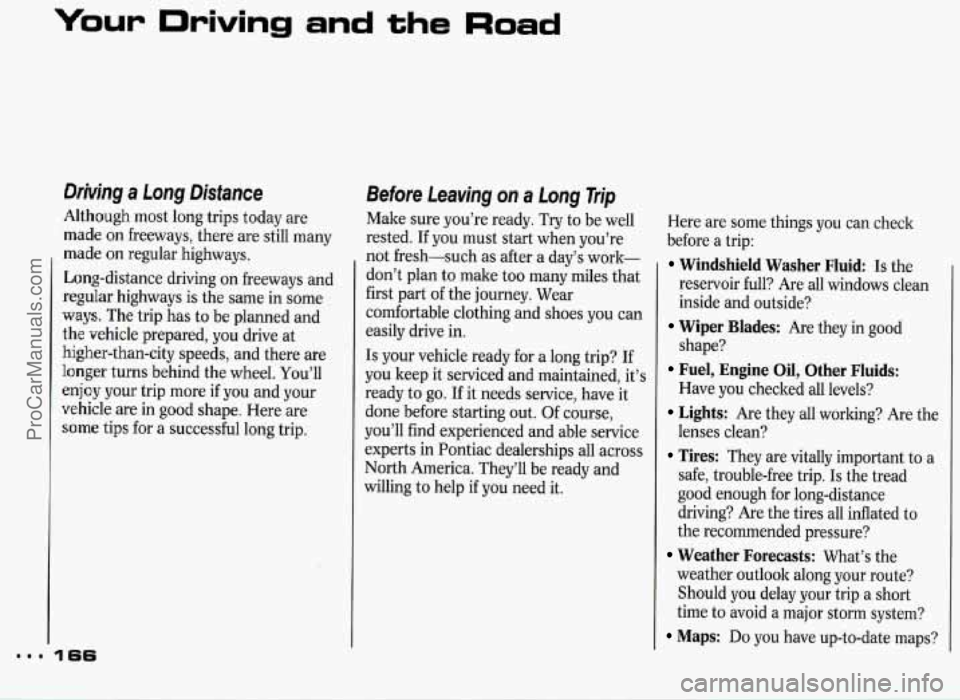
Your Driving and the Road
Drkjng a Long Distance
Although most long trips today are
made on freeways, there are still many
made
on regular highways.
Long-distance driving on freeways and
reguIar highways is the same in some
ways. The trip has to be planned and
the vehicle prepared, you drive at
higher-than-city speeds, and there are
longer turns behind the wheel. You’ll
enjoy your trip more if you and your
vehicle are in good shape. Here are
some tips for a successful long trip.
Before Leaving on a Long Trip
Make sure you’re ready. Try to be well
rested. If you must start when you’re
not fresh-such as after a day’s work-
don’t plan to make too many miles that
first part of the journey. Wear
comfortable clothing and shoes you can
easily drive in.
Is your vehicle ready for a long trip? If
you keep it serviced and maintained, it’s
ready to go. If it needs service, have it
done before starting out. Of course,
you’ll find experienced and able service
experts in Pontiac dealerships all across
North America. They’ll be ready and
willing to help
if you need it. Here
are some things you can check
before a trip:
Windshield Washer Fluid Is the
reservoir full? Are all windows clean
inside and outside?
shape?
Have you checked all levels?
lenses clean? safe, trouble-free trip.
Is the tread
good enough for long-distance
driving? Are the tires all inflated to
the recommended pressure?
weather outlook along your route?
Should
you delay your trip a short
time to avoid a major storm system?
Maps: Do you have up-to-date maps?
Wiper Blades: Are they in good
Fuel, Engine Oil, Other Fluids:
Lights: Are they all working? Are the
Tires: They are vitally important to a
Weather Forecasts: What’s the
ProCarManuals.com
Page 169 of 338
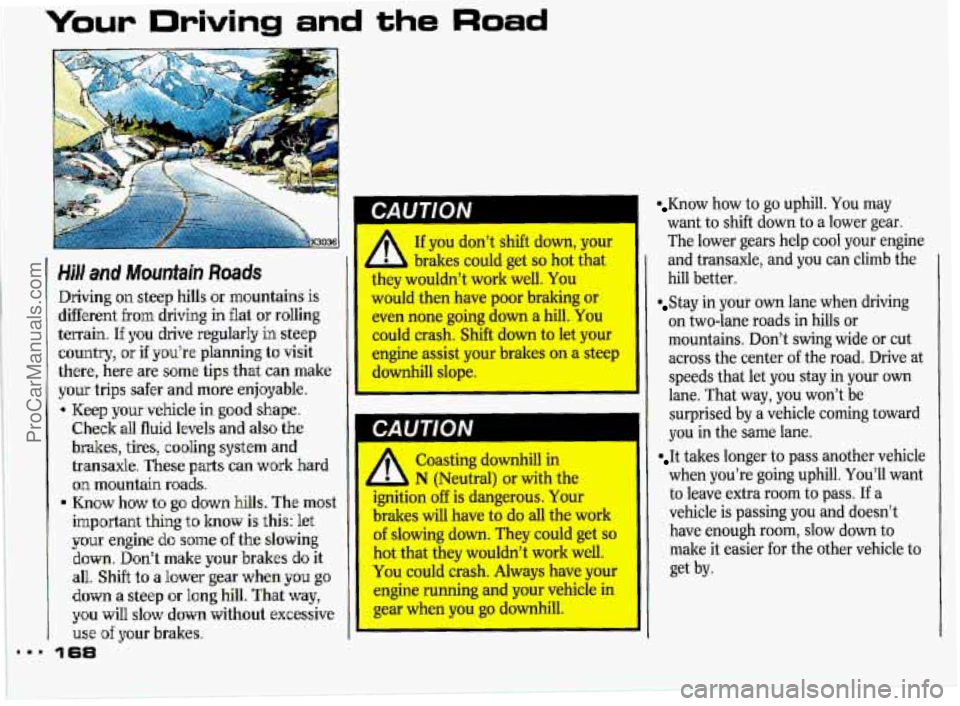
your Driving and the Road
-1
HM and Mountain Roads
Driving on steep hills or mountains is
different fiom driving in flat or rolling
terrain.
If you drive regularly in step
country, or if you’re planning to visit
there, here are some tips that can make
your trips safer and more enjoyable.
* Keep your vehicle in go’od shape.
Check all fluid levels and also the
brakes, tires, co’oling system and
transaxle. These
parts can work hard
~n mountain roads.
. K~QW how to go, down hills. The most
important thing
to how is this: let
your engine do some of the slowing
down. Don’t make your brakes do it
an.. Shift to a lower gear when YQU go
down a steep or long hill. That way,
you will slow down without excessive
use of your brakes.
168
If you don’t shift down, your
brakes could get
so hot that
they wouldn’t work well. You
would then have poor braking or
even none going down a hill.
You
could crash. Shift down to let your
engine assist your brakes on a steep
downhill slope.
I
A Coasting downhill in
- N (Neutral) or with the
* ignition off is dangerous. Your
akes will have
to do all the work
slowing down. They could get
so
riot that they wouldn’t work well.
You could crash. Always have your
Pngine running and your vehicle in
a-ar when you
go downhill.
Know how to go uphill. You may
want to shift down to a lower gear.
The lower gears help
cool your engine
and transaxle, and you can climb the
hill better.
Stay in your own lane when driving
on two-lane roads in hills or
mountains. Don’t swing wide or cut
across the center
of the road. Drive at
speeds that let you stay in your own
lane. That way, you won’t be ’ surprised by a vehicle coming toward
you in the same lane.
It takes longer to pass another vehicle
when you’re going uphill. You’ll want
to leave extra room to pass. If a
vehicle is passing you and doesn’t
have enough room, slow down to
make it easier for the other vehicle to
get by.
ProCarManuals.com
Page 178 of 338
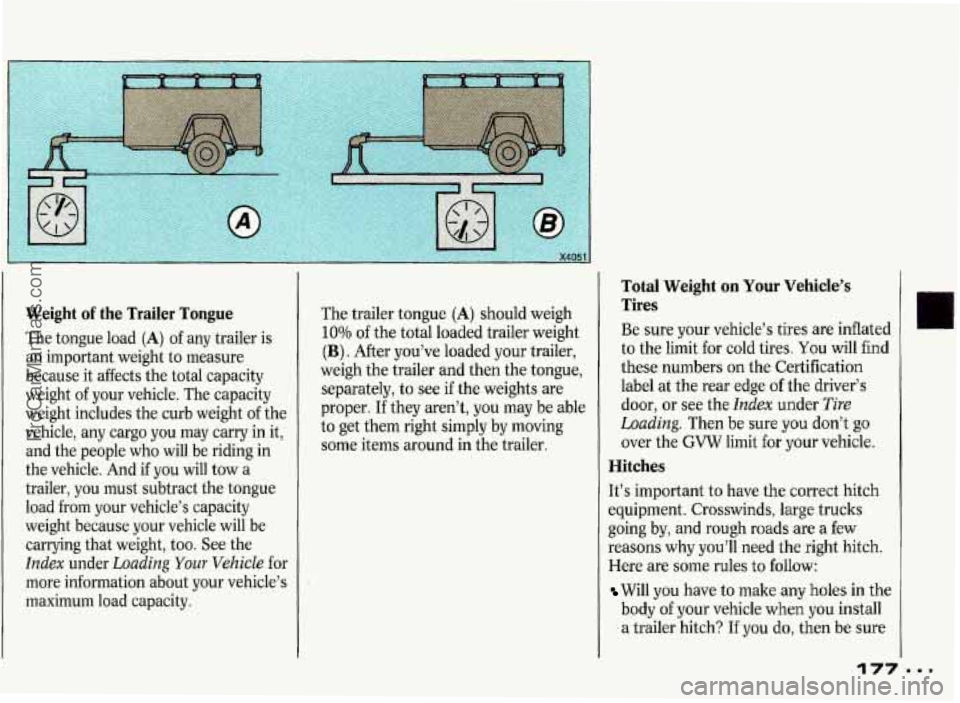
Weight of the Trailer Tongue
The tongue load (A) of any trailer is
an important weight to measure
because it affects the total capacity
weight of your vehicle. The capacity
weight includes the curb weight of the
vehicle, any cargo you may carry in it,
and the people who will be riding in
the vehicle. And if
you will tow a
trailer, you must subtract the tongue
load from your vehicle’s capacity
weight because your vehicle will be
carrying that weight, too.
See the
Index under Loading Your Vehicle for
more information about your vehicle’s
maximum load capacity. The
trailer tongue
(A) should weigh
10% of the total loaded trailer weight
(B). After you’ve loaded your trailer,
weigh the trailer and then the tongue,
separately, to see
if the weights are
proper. If they aren’t,
you may be able
to get them right simply by moving
some items around in the trailer.
Total Weight on Your Vehicle’s
Tires
Be sure your vehicle’s tires are inflated
to the limit for cold tires.
You will find
these numbers on the Certification
label at the rear edge
of the driver’s
door,
or see the Index under Tire
Loading.
Then be sure you don’t go
over the GVW limit for your vehicle.
Hitches
It’s important to have the correct hitch
equipment. Crosswinds, large trucks
going by, and rough roads are a few
reasons
why you’ll need the right hitch.
Here are some rules to
follow:
Will you have to make any holes in the
body of your vehicle
when you install
a trailer hitch? If you
do, then be sure
177
ProCarManuals.com
Page 184 of 338
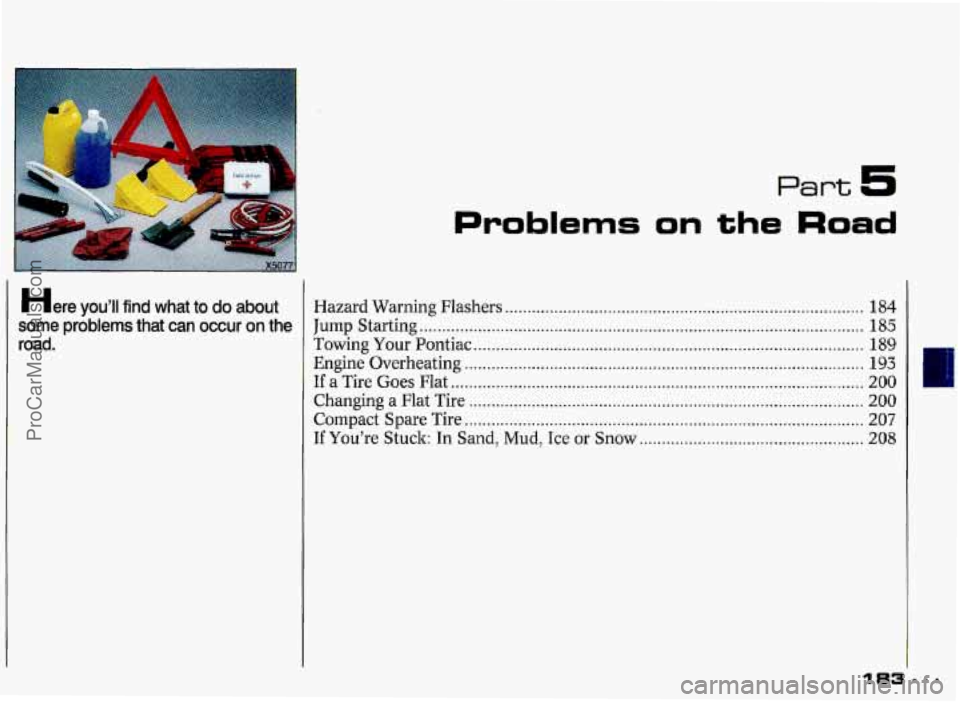
Here you’ll find what to do about
some problems that can occur on the
road
.
Part 5
Problems on the Road
Hazard Warning Flashers ........................................................................\
........ 184
Towing Your Pontiac ........................................................................\
............... 189
Engine Overheating ........................................................................\
................. 193
If a Tire Goes Flat ........................................................................\
.................... 200
Changing a Flat Tire ........................................................................\
................ 200
Compact Spare Tire ........................................................................\
................. 207
If You’re Stuck: In Sand, Mud. Ice or Snow .................................................. 208
Jump Starting ........................................................................\
........................... 185
ProCarManuals.com
Page 201 of 338
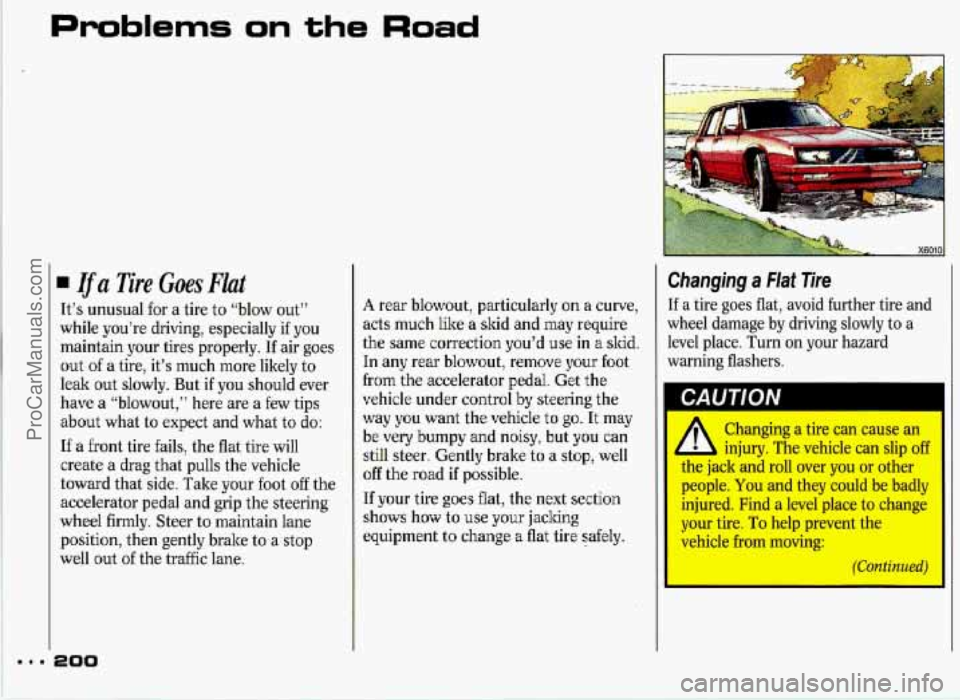
Problems on the Road
.I.
It’s unusual for a tire to “blow out”
while you’re driving, especially if
you
maintain your tires properly. If air goes
out
of a tire, it’s much more likely to
leak out slowly. But if you should ever
have
a “blowout,” here are a few tips
about what to expect
and what to do:
If
a front tire fails, the flat tire will
create a drag that pulls the vehicle
toward that side. Take your foot
off the
accelerator pedal and grip the steering
wheel firmly. Steer to maintain lane
position, then gently brake to a stop
well out of the traffic lane.
2010
A rear blowout, particularly cm a curve,
acts
much like a skid and may require
the same correction
you’d use in a skid.
In any rear blowout, remove pur bot
from the accelerator pedal. G,et the
vehicle under control by steering the
way
you want the vehicle to go. It may
be very bumpy and noisy, but you can
still steer, Gently brake to a stop, well
off the road if possible.
If your tire goes flat, the next se’ction
shows how
to use your jacking
equipment to change a flat tire safely.
Changing a Flat Tire
If a tire goes flat, avoid further tire and
wheel damage by driving slowly to a
level place. Turn
on your hazard
warning flashers.
A Changing a tire can cause an
injury. The vehicle can
slip off
the jack and roll over you or other
people.
You and they could be badly
injured.
Find a level place to change
your tire. To help prevent the
vehicle from moving: I
I (Continued)
ProCarManuals.com
Page 203 of 338
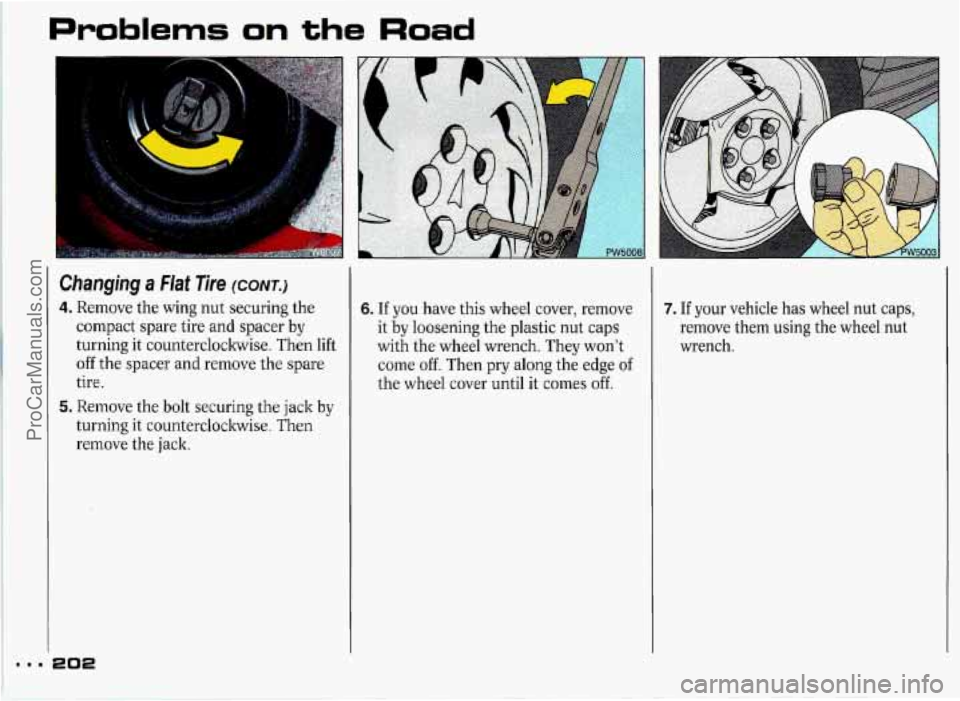
m..
Problems on the Road
Changing a Flat Tire (CONT.)
4. Remove the wing nut securing the
compact spare tire and spacer
by
turning it countercloclnvise. Then lift
off the spacer and remove the spare
tire.
5. Remove the bolt securing the jack by
turning it countercloclwise. Then
remove the jack.
202
6. If you have this wheel cover, remove
it by loosening the plastic nut caps
with the wheel wrench. They won't
come off. Then pry along the edge
of
the wheel cover until it comes off.
7. If your vehicle has wheel nut caps,
remove them using the wheel nut
wrench.
ProCarManuals.com
Page 205 of 338
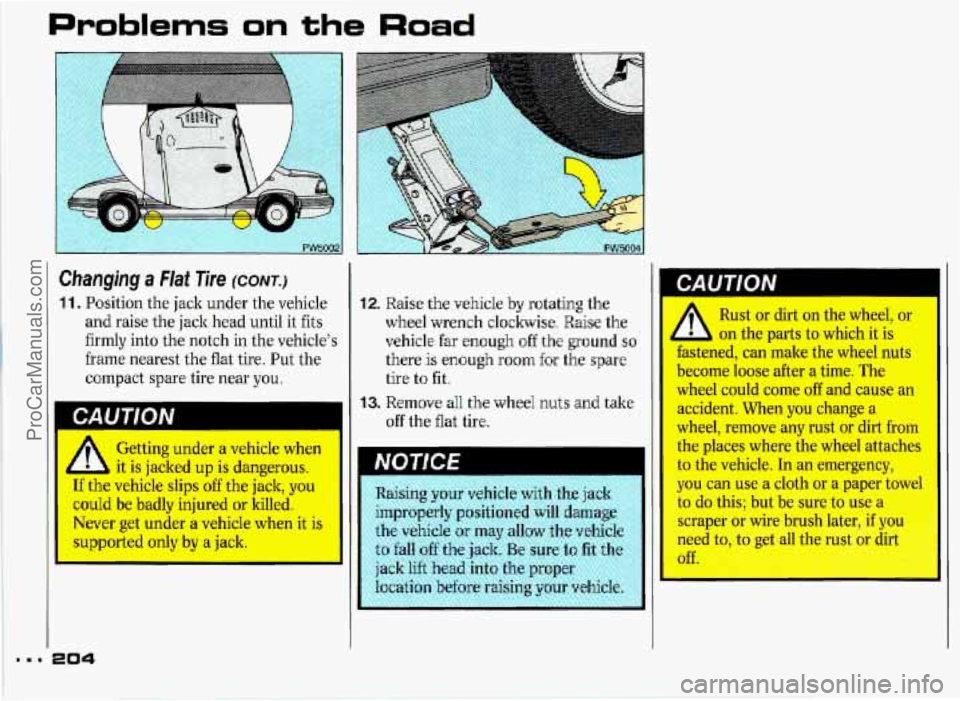
Problems on the Road
Changing a Hat Tire (CONT.)
11. Position the jack under the vehicle
and raise the jack head until it fits
firmly into the notch in the vehicle’s
frame nearest the flat tire. Put the
compact spare tire near
you.
LAU f IVN
Getting under a vehicle when
L it is jacked up is dangerous.
If the vehicle slips off the jack, you
could be badly injured or killed.
Never get under
a vehicle when it is
supported.
only by a jack.
12. Raise the vehicle by rotating the
wheel wrench cloclwise.
Raise the
vehicle far enough
off the ground so
there is emugh morn for the spare
tire to fit.
13. R’ernove all the u7heel nuts and take
off the flat tire.
~~ ~
I Kaising your vehicle with the jack
improperly positioned will damage
the vehicle
or may allow the vehicl,
to fall
off the jack. Be sure to fit the
jack lift head into the proper
location before raising your vehick Rust
or dirt on the wheel, or
4 b on the parts to which it is
fastened, can make the wheel nuts
become loose after a time. The
wheel could come off and cause an
accident. When you change a
wheel, remove any rust
or dirt from
the places where the wheel attaches
to the vehicle. In an emergency,
you can use a cloth or a paper towel
to do this; but be sure to use a
scraper or wire brush later, if you
need
t ;et all 1 rust or dirt
L
(
ProCarManuals.com
Page 207 of 338
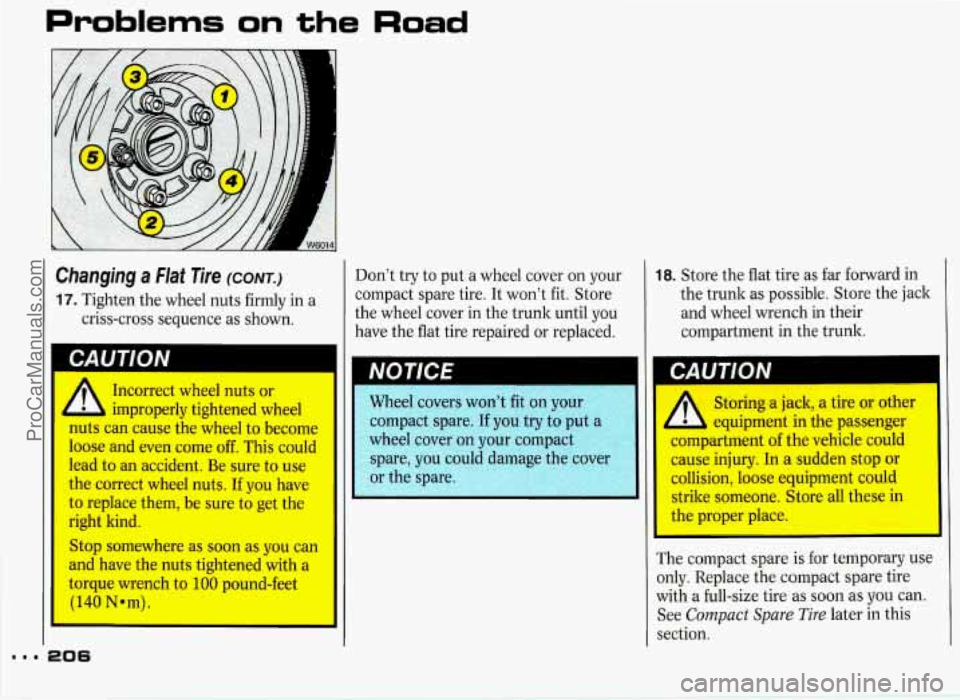
Problems on the Road
Changing a Flat Tire (CONT.)
17. Tighten the wheel nuts firmly in a
criss-cross sequence as shown.
11 CAUTION 'I
Incorrect wheel nuts or
improperly tightened wheel
nuts can cause the wheel to become
loose and even come off. This could
lead to an accident. Be sure to use
the correct wheel nuts.
If you have
to replace them, be sure to get the
right kind.
Stop somewhere as soon as you can
and have the nuts tightened with a
torque wrench to
100 pound-feet
(140 Nmm).
Don't try to put a wheel cover on your
compact spare tire.
It won't fit. Store
the wheel cover in the trunk until you
have the flat tire repaired or replaced.
I meel covers won't fit on your
compact spare. If you try to put
a
wheel cover on your compact
spare, you could damage the cover
or the spare.
I
18. Store the flat tire as far forward in
the trunk as possible. Store the jack
and wheel wrench in their
compartment in the trunk.
Storing
a jack, a tire or other
equipment in the passenger I
compartment of the vehicle could
cause injury.
In a sudden stop or I
collision, loose equipment could
strilce someone. Store all these
in
the proper place. I
The compact spare is for temporary use
only. Replace the compact spare tire
with a full-size tire as
soon as you can.
See
Compact Spare Tire later in this
section.
ProCarManuals.com
Page 208 of 338
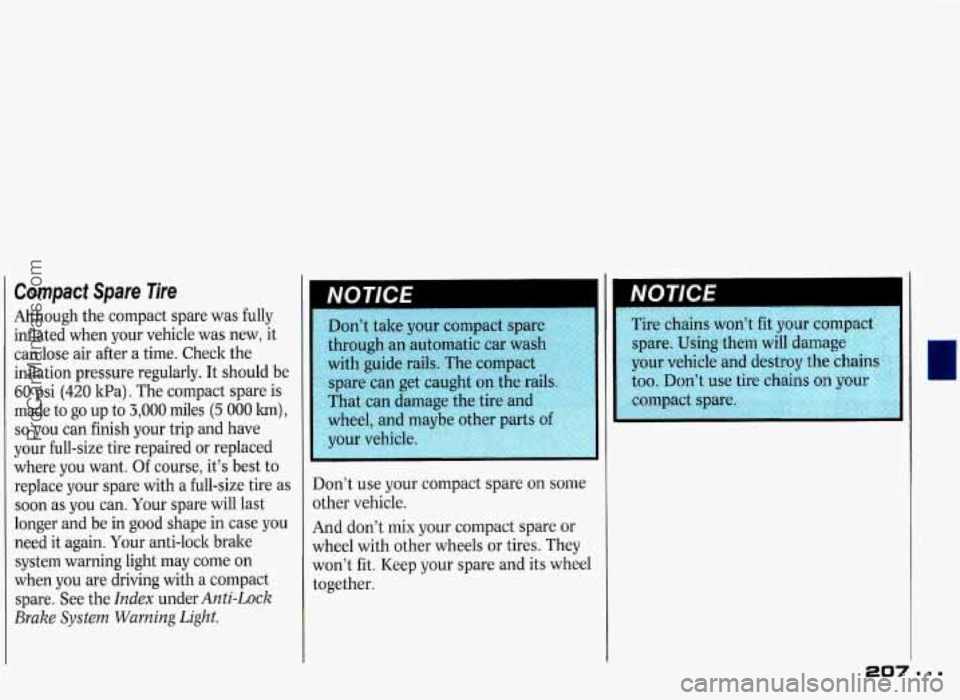
Compact Spare Tire
Although the compact spare was fully
inflated when your vehicle was new, it
can lose air after a time. Check the
inflation pressure regularly. It should be
60 psi (420 1tPa). The compact spare is
made to go up to 3,000 miles (5 000 lm),
so you can finish your trip and have
your full-size tire repaired or replaced
where you want. Of course, it’s best to
replace your spare with a full-size tire as
soon as you can. Your spare will last
longer and be in good shape in case you
need it again. Your anti-lock brake
system warning light may come on
when
you are driving with a compact
spare. See the
Index under Anti-Lock
Brake System Warning Light.
take your compact spare
through an automatic car wash
with guide rails. The compac
spare can get caught
on the r
That can damage the tire and
wheel, and ma
your vehicle
Don’t use your compact spare on some
other vehicle.
And don’t mix your compact spare or
wheel with other wheels or tires. They
won’t fit. Keep your spare and its wheel
together.
NU I IL‘t
Tire chains won’t fit your compact
spare. Using
them will damage
your vehicle and destroy the chains
too. Don’t use tire chai
ProCarManuals.com